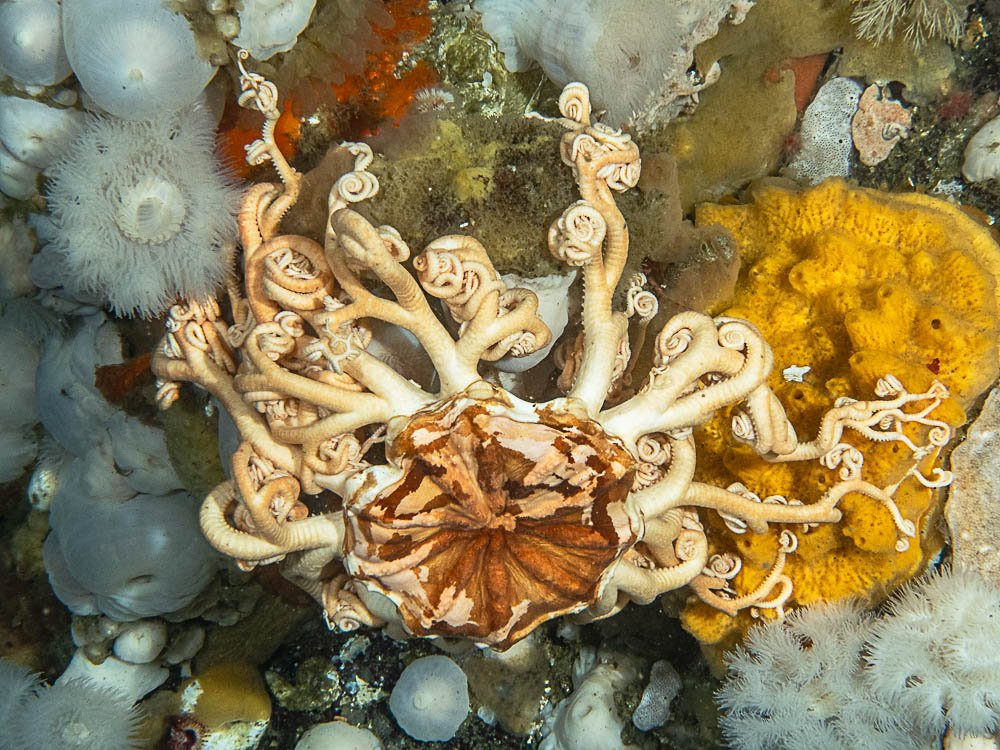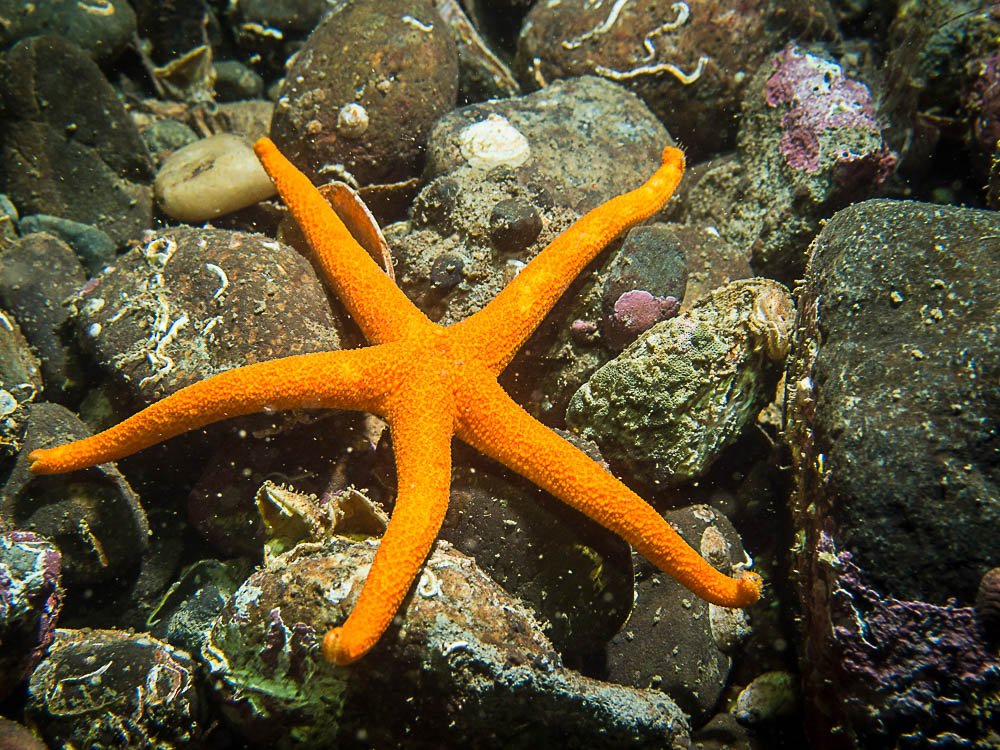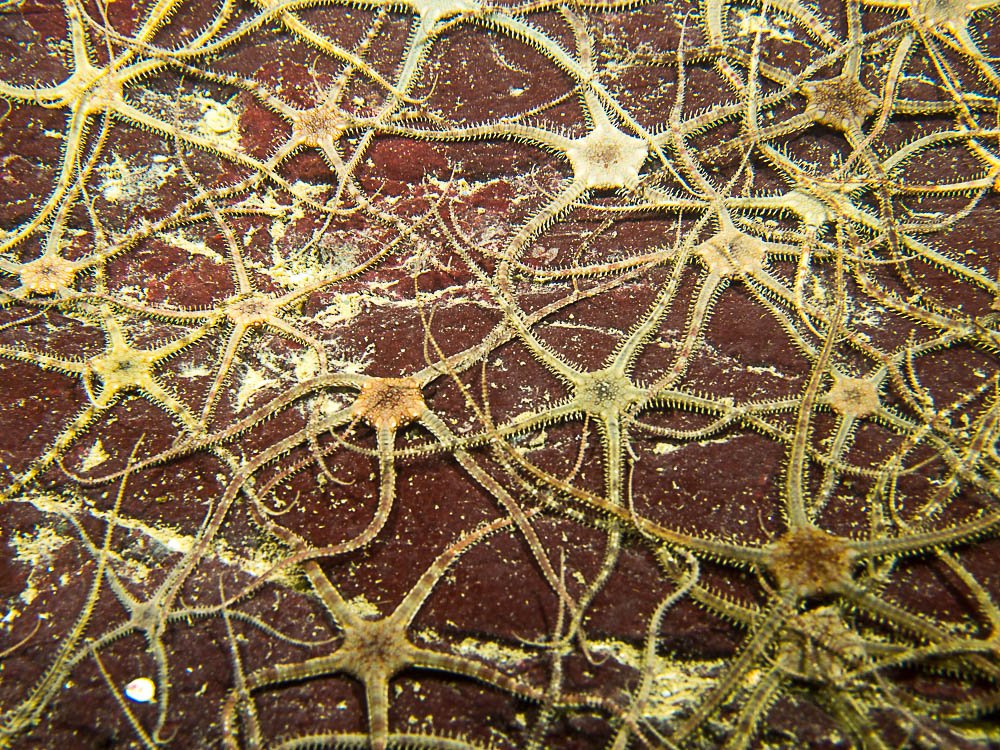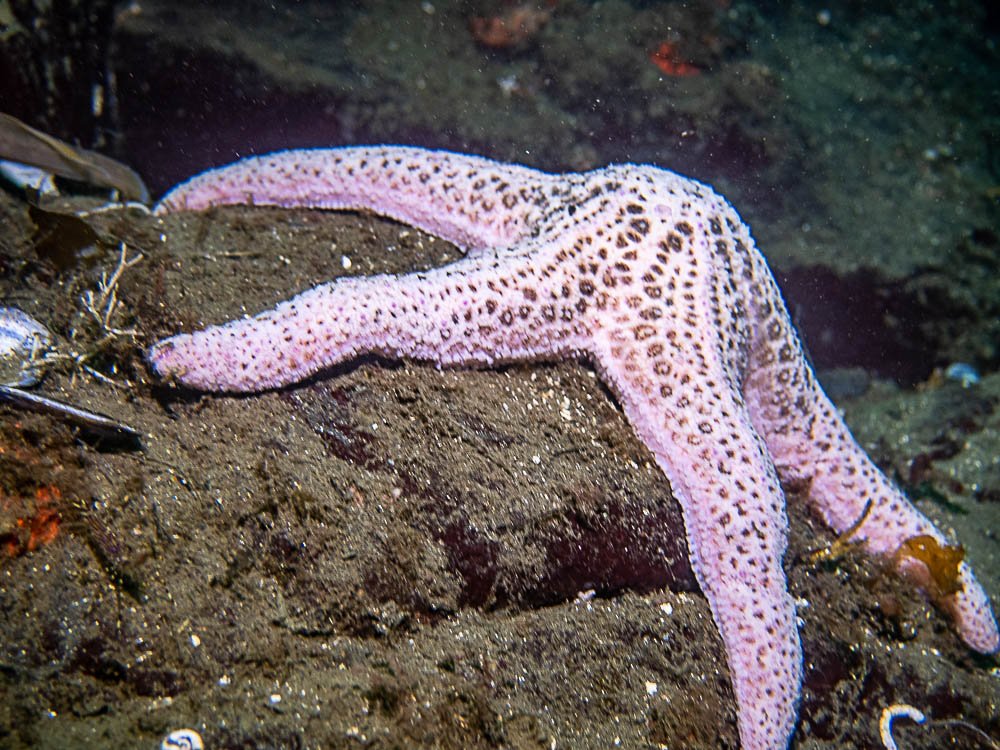Taking Care of our stars
Text & images Thom Robbins
Starfish, or sea stars, are some of the ocean's most fascinating creatures. They lack brains and blood, digest food outside their bodies, and can regenerate lost limbs—sometimes even growing a new starfish from a single severed arm. In the colorful, thriving world of the Salish Sea, starfish stand out for their beauty and vital role in the ecosystem.
Beyond their striking appearance, starfish play a crucial role in maintaining balanced ecosystems. As keystone species, they regulate the populations of other marine animals, maintaining ecosystem balance. Without them, the entire system can become unbalanced, affecting many different species.
Starfish or Sea Stars?
While 'starfish' and 'sea star' are often used interchangeably, sea star is the scientifically accurate name. The reason is simple: sea stars are not actually fish. They lack scales, fins, and gills, which are essential characteristics of true fish. Regardless of this, 'starfish' remains the popular term in everyday language!
Diving into our local waters reveals a world of intricate ecological connections, with starfish acting as caretakers, maintaining the delicate balance of their underwater habitat.
One of everyone's favorites, the Ochre Sea Star, (shown above) with its vivid shades of purple, orange, and yellow, plays a crucial role in the Salish Sea. It's role of preying on oysters, mussels, and barnacles maintains an intertidal population balance and diverse marine ecosystem. Some aquaculture farmers may not agree, but without sea stars, oysters would dominate the habitat and disrupting the ecosystem balanc
30 Local Stars
Of the 2,000 species worldwide, over 30 sea stars are found locally, adapted to the cool, nutrient-rich waters. This includes the vibrant Rainbow Star, known for its striking red and orange hues, often seen in rocky subtidal areas. This species is an active predator, feeding on urchins, snails, and even other starfish. Another intriguing species is the Vermilion Star, which inhabits deeper waters and stands out with its bright red hue. It primarily feeds on sponges and small invertebrates, slowly moving along the seafloor for prey.




Starfish belong to a diverse group of marine animals called echinoderms, which include sea urchins, sand dollars, and sea cucumbers. Echinoderms are characterized by radial symmetry, often with a five-point structure, though some species can have more arms. They also have unique skin, which ranges from smooth and velvety to spiny and rough. Their internal skeleton is made of calcium carbonate plates, giving them strength and flexibility.
Water for Blood
Instead of blood, sea stars pump seawater through a network of canals called the water vascular system. This system powers their movement, helps them breathe, and delivers nutrients throughout their bodies. By filtering seawater stars can absorb the oxygen and nutrients they need to survive.
By pumping seawater, they extend and retract tiny tube feet on their arms, which act like suction cups. This enables them to crawl across the ocean floor, clinging to rocks and rough surfaces. Some species do this surprisingly fast. the Sunflower Sea Star can travel up to a meter per minute!
Vermillion Star
Some sea stars use their suction-cup tube feet to pry open mussels, clams and oysters, exerting pressure with their tube feet up to ten times their body weight, giving them the power to open even the most tightly closed shells.
Once a starfish has pried open a shell just enough, it does something extraordinary—it extends its stomach out of its body and into the shell. This allows it to digest the prey externally, turning the meal into a liquid form that it can absorb into its body. This method of external digestion makes it easier for starfish to consume prey that would otherwise be too large to eat.
Each species has evolved distinct feeding strategies. For instance, the Leather Star has been known to drill tiny holes into the shells of its prey, providing access to hard-to-reach food sources.
A New Limb
One of the most fascinating features of starfish is their incredible ability to regenerate. Losing a limb isn’t the end for a starfish; it’s an opportunity for renewal. They can grow back a severed arm and, in some cases, even regenerate an entire body from just a part of a limb, as long as it includes part of the central disc.
This ability comes from specialized cells in their arms that can transform into the various types of cells needed for regrowth. This regenerative power helps them escape predators, heal from injuries, and even reproduce, making them incredibly resilient. Scientists are studying this ability not just to understand marine life better but also to explore its potential applications in medical research, offering new insights into how cells can regenerate and repair.
Each starfish species has adapted to thrive in its niche within the diverse marine environment. For instance, the Blood Star is well-suited to the cooler, deeper waters of the Pacific, where it feeds primarily on organic detritus and sponges. Unlike intertidal species, the Blood Star can be found on rocky reefs and sandy bottoms. Its bright red or orange coloration helps it stand out. Yet, it has developed the ability to blend into its surroundings when threatened, making it resilient and adaptable.
Deep-dwelling species like the Giant Pink Sea Star prefer the quiet, dark seabed. These starfish are found moving across the ocean floor, searching for prey like sponges and other slow-moving animals. The Velcro Star is known for its smooth, fluid movement. Their tube feet glide effortlessly over different surfaces in a coordinated, wave-like pattern. This technique lets it navigate tricky terrains, such as rocky crevices and dense kelp beds, with agility and speed. Its graceful movement, combined with a varied diet of algae, small invertebrates, and detritus, makes the Velcro Star highly adaptable across Pacific marine habitats.
The Bat Star, are often found in tide pools using their arms to sense the world around them. Each species has found a way to survive and thrive, whether braving the harsh intertidal zone, navigating the deep sea, or at home in tide pools.
Who needs a Brain?
Starfish have a decentralized nervous system rather than a central brain. This system consists of a nerve ring around their mouth, which connects to radial nerves running down each arm. Each arm acts independently, allowing the starfish to respond to its environment without a central control center.
The radial nerves help the starfish detect changes in temperature, light, touch, and the presence of chemicals in the water. Starfish may not have eyes like ours, but their keen sense of their surroundings helps them survive and thrive in a complex and sometimes harsh environment. Through research, conservation efforts, and sustainable practices, we may ensure that these celestial emblems of the ocean continue to thrive.
Starfish Lifecycle
The lifecycle of a starfish begins with species releasing vast clouds of sperm and eggs into the water, allowing fertilization to occur freely in the open sea. Once these eggs are hatched, starfish begin life as tiny, free-swimming larvae called bipinnaria. The larvae look nothing like their star-shaped adult selves. They resemble translucent creatures with cilia that help them move. Feed on microscopic plankton, life is perilous for these young starfish. They drift with the currents, exposed to predators and other dangers, with only a fraction progressing to the next development stage. They gradually transform into brachiolaria larvae, developing the first signs of the star-like body.
After months of drifting, the larvae transform dramatically, settling onto the seafloor and developing into juvenile starfish. This stage is crucial as they switch from a free-swimming lifestyle to one anchored to the ocean floor. Once settled, they start to look more like the familiar star-shaped adults, with their tube feet ready to help them move and search for food. Different species have their unique spawning behaviors. The Sunflower Sea Star, known for its speed and many arms, can produce thousands of eggs simultaneously, increasing the chances that some will survive despite the high predation risk. In contrast, the Leather Star releases fewer eggs throughout the season, spreading their reproductive efforts. Starfish have surprisingly long lifespan. The Red Sea Star lives up to 20 years. Their longevity allows them to play a vital role in maintaining the balance of their ecosystems. Each stage of their lifecycle, from tiny drifting larvae to powerful adult predators, is a testament to their resilience, intricately linked to the currents and tides.
Wasting Disease
Starfish wasting disease
Sea stars are adapted to withstand harsh conditions, like as pounding waves, intense heat, and dry low tides. However, during the 2014-2016 marine heatwave, ocean temperatures made them more susceptible to sea star wasting disease causing a populations decline from Mexico to Alaska. Sea star wasting disease (SSWD) is a condition that causes lesions, limb loss, and disintegration. It has been linked to Sea Star-associated Densovirus (SSaDV). Researchers have found higher concentrations of this virus in sick sea stars compared to healthy ones. The virus attacks their tissues, breaking down the body and spreading through shared habitats and even the water. This has been especially devastating for the Sunflower Sea Star. By 2021, it was estimated that up to 90% of the West Coast Sunflower Sea Star population were lost due to this disease. As a primary predators of sea urchins, their absence has led to a surge in urchin populations. Sea urchins began to overgraze kelp forests, resulting in "urchin barrens," areas where kelp has been decimated, leading to the loss of shelter and food for fish and invertebrates. This imbalance's ripple effects highlight how crucial sea stars are to maintaining a healthy ecosystem. Their decline affects the immediate species they prey on and can lead to broader shifts, impacting the entire marine food web. Researchers are exploring solutions including breeding disease-resistant sea stars. Some facilities have raised sea stars in captivity and released them into the wild, hoping to restore populations and introduce more resilient individuals. While challenges remain, efforts continue to understand this devastating disease.
As keystone species, starfish play a critical role in aquatic ecosystems. Today, starfish face numerous threats, from rising ocean temperatures and pollution to habitat loss and the spread of sea star wasting syndrome. Conservation efforts, such as breeding disease-resistant starfish and monitoring sea star health, are crucial to ensure these creatures continue to thrive.







